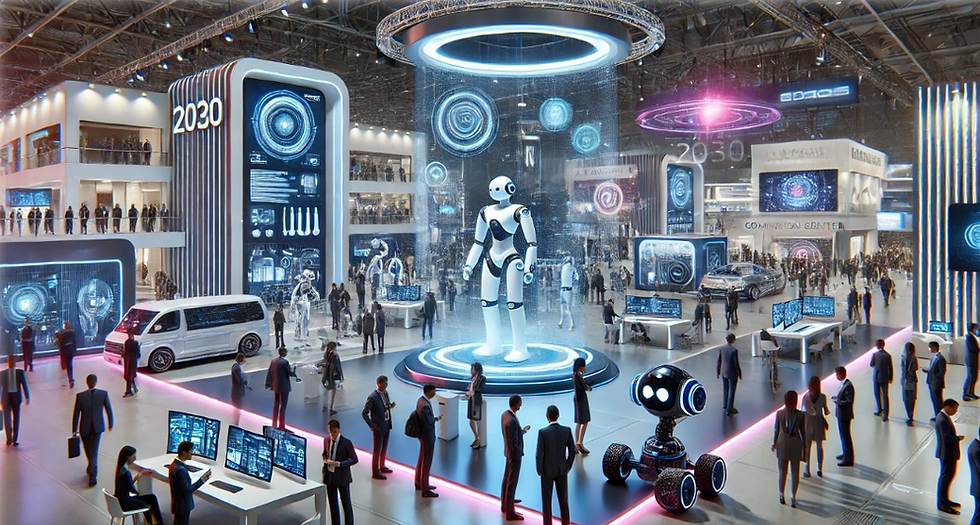The Future of Trade Shows
- bobmcglincy
- Apr 9
- 3 min read
Updated: Apr 14

The future of trade shows is not about events on the moon, teleportation to meetings, or mind-meld connections for sharing experiences. The future will be smart booths, interactive tech, networking, live crowds, face-to-face engagement, and personalization.
Current and Future Trends
AI. The Department of Defense began funding Artificial Intelligence research in the sixties. Today, AI enhances communication and accelerates analysis and content production. It can impact all phases of a trade show: from improving security and event planning, to logistics and production; from speeding registration and attracting crowds, to influencing networking, and designing exhibits. AI is quick, but not always accurate. AI will eliminate some jobs and create others. It can provide more insight, but at a cost of bias, occasional mistakes, and less privacy.
Data Analysis. Tracking and analyzing data and behavior in real time is critical to the success of any business … and the companies that do so will be the ones to succeed. Programs for the measurement of ROI have been available for decades but were often ignored or under-utilized. Today’s faster computers are “thinking machines”, capable of analyzing vast amounts of data and making recommendations.
Hybrid Events. The pandemic proved the need for face-to-face meetings. Virtual events alone do not work, but a combination of both live and virtual can create a richer experience. Hybrid formats allow for live streaming and remote participation. Digital connections allow for online engagement both before and after the show, all year long.
Sustainability. Eco-friendly materials and energy efficiencies will reduce waste. Recyclable and biodegradable booths, rentals, modulars, and custom resizable exhibits will help, as will less printed matter and more digital communications.
Globalization. The world of trade shows is shrinking, but the opportunity for business is expanding. There are more international shows, in more countries, with greater participation in terms of the numbers of exhibitors and attendees. Including other cultures improves the value of a show.
Generational Differences. There are major differences between generations in terms of attitudes, preferences and lifestyles. This must be addressed in attracting attendees. But people are more similar than different. We are all human; and we share a basic need for human interaction and connection. There is no substitute for face-to-face. Show management will create personalized options, promote local experiences and stress work/life balance.
Mergers, Acquisitions and consolidations will continue. Major corporations, show management associations, exhibit houses and service contractors will all be impacted. The number of companies and mega-shows will decrease. But the opportunities for entrepreneurs and regional shows will increase.
Advanced Tech Integration. Technology is changing the way we display products and information, as well as the way we interact with attendees. Data sharing, data analysis, and automation affect decision making. Holograms, 3-D imaging, AR, VR, MR, XR enhance engagement and enrich the show floor experience.
Labor Shortages. The dearth of talented and experienced individuals is alarming, and the most critical need facing our industry. One 2023 MPI report stated “65% of (our) workforce is new”. Many baby boomers have retired, are retiring, or soon will be retiring. There is a need for a more diverse and younger workforce, and a need for gig workers. Most of all there is a need for increased industry advocacy – a need for getting the word out about opportunities in this remarkable industry.
Life on the Show Floor
Registration. Biometric and touchless check-ins, coupled with QR code scanning and facial recognition, will become more commonplace, as will an emphasis on security, health and wellness, and the issuance of smart badges.
Smart Booths will engage audiences, starting with facial recognition. Brand architecture will continue to be impressive and inviting, with even more AV. Picture IMAX on the show floor with video walls offering 360-degree views … or interactive touchscreens, kiosks, product demos and digital signage … or immersive content like holograms, and virtual reality. All technology, yes, but it will be about personalizing the experience and making it memorable. Real time engagement will bring instant feedback.
Drones and Robots. In cities where the venues and work rules allow it, drones may fly overhead, and robots might perform certain tasks: Lay out the floor. Deliver small packages. Vacuum carpets. Answer questions. Assist attendees. Move freight.
The Future is Now
As the future speeds towards us and makes changes, some things will remain the same. Trade shows will continue to bring buyers and sellers together in a face-to-face environment. Trade shows will continue to generate business, benefit local economies and create millions of jobs nationwide. If we take care of business and nothing too crazy in the world happens, this will continue into the decades ahead. The best way for us to deal with the future is to begin designing it ourselves today.
.png)



Comments